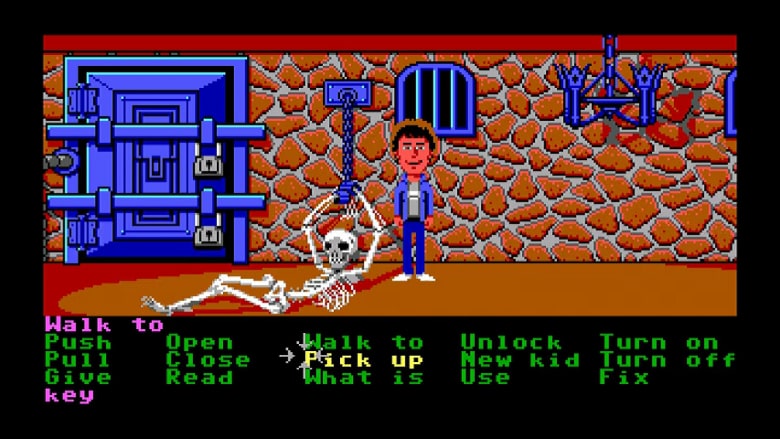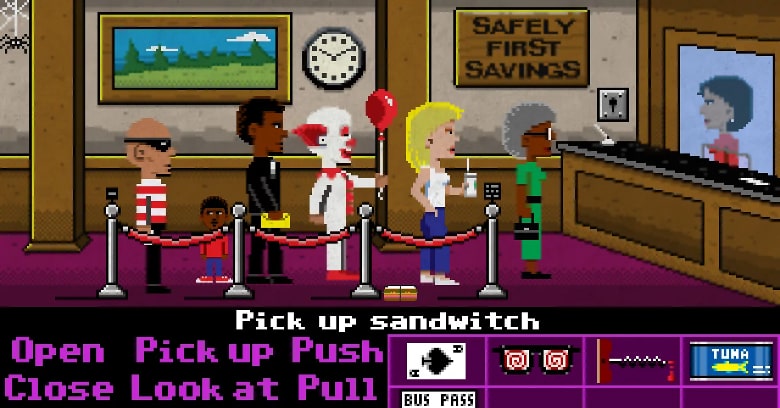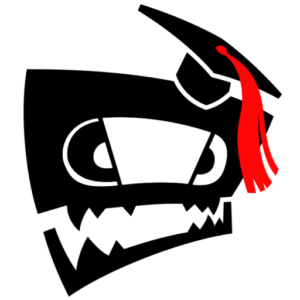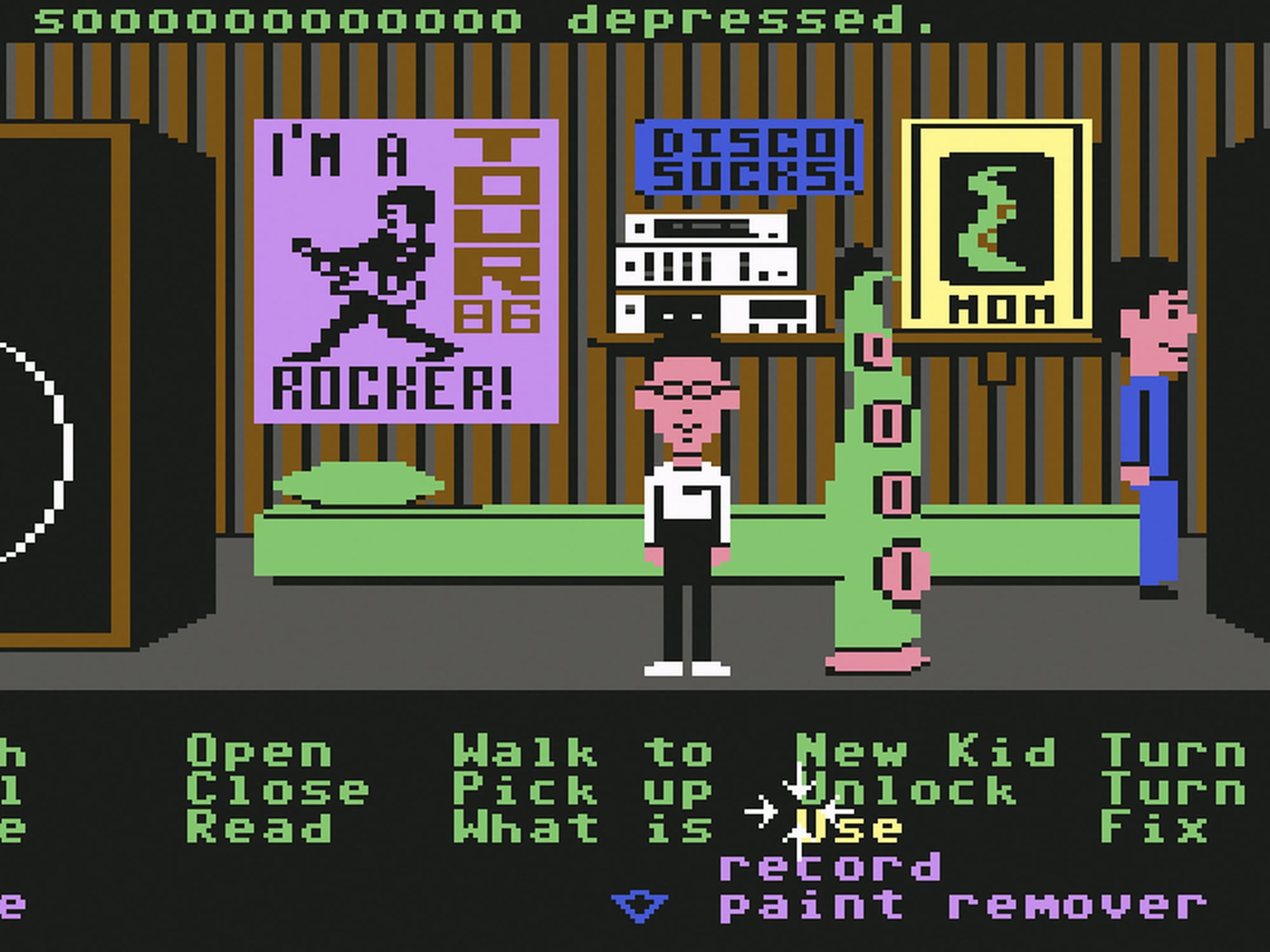Graphical adventures were the rising star of gaming in the 1980s. A genre defined with interactive storylines driven by exploration and puzzles. Many offered players a text parser to input commands. This could become a vexing experience to get the precise arrangement of words to advance the game.
Eventually, the point-and-click interface was adapted as a standard for interactive fiction, beginning with an unlikely project published by LucasArts in 1987. Borrowing heavily from B-films and fantasy comics, Ron Gilbert and Gary Winnick created the dark humored gaming experience, Maniac Mansion. Platforms like the Commodore 64 introduced this unique game to the world.
The Game History/Censorship
Gilbert and Winnick met in 1984 while working at LucasArts. Both fans of sci-fi schlock, they became fast friends over a shared love for horror films. After the completion of Koronis Rift, the pair toyed with the idea of a horror comedy game of their own. Originally mapping their ideas as a paper-and-pencil game, they set their plot in a haunted house and added popular horror tropes.
The format of King’s Quest I would inspire the vehicle for Gilbert and Winnick’s brain project. An interactive adventure game with a point-and-click interface instead of fumbling with a parser. This was the birth of the SCUMM engine, an acronym for Script Creation Utility for Maniac Mansion. This programming engine featured a verb/object design paradigm and was utilized for many other games.
After 2 grueling years of development, Gilbert and Winnick’s Maniac Mansion game debuted at the 1987 Consumer Electronics Show. One of LucasArts’s first self-published games, the initial release introduced many Maniac Mansion platforms: Commodore 64, Apple II, an MS-DOS port in 1988, and then ports for Atari ST, Amiga, MAC, and NES in 1990.
“Don’t be a tuna head!”
During the game’s development for one of the first Maniac Mansion platforms, Commodore 64, Lucasfilm had censored profanity in the dialog much to the irritation of Gilbert. This resulted in some ridiculous 80s lingo like “tuna head.” The game would later be pulled from shelves in Toys R Us, just a few months after release, all due to a letter from a single consumer about the word “lust” being printed on the game box.

Shortly after being ported to NES, Nintendo of America expressed concern over suggestive content. Aiming for a younger audience, Nintendo requested LucasArts tone down what they deemed inappropriate content, such as pixelated allusions to nudity and graphic dialog like the word “kill.” The most laughable censoring issue was the phrase “NES SCUMM created by” in the credits sequence. Not realizing it was the name of the development engine, Nintendo took it as a direct insult and requested it be removed. Funny enough, the company somehow missed the ability to microwave a live hamster.
Gameplay
The Maniac Mansion game begins 20 years prior with a meteor crash-landing in the backyard of the titular building. Purple and sentient, the meteor enslaves the mind of homeowner, Dr. Fred Edison. On the anniversary of the incident in present time, our brainwashed doctor has kidnapped Sandy Pantz, a local teenage girl that Dr. Fred plans to suck the brains out of for an experiment. Sandy’s boyfriend, Dave Miller, rallies a handful of his friends from school in an attempt to infiltrate the Edison mansion and rescue her. Punks and nerds unite to put a stop to this mad science, encountering the rest of the Edison family along the way. Dr. Fred’s raunchy wife, Nurse Edna and their military obsessed son, Weird Ed. Also inhabiting the house are two sentient tentacles, a kind green tentacle and evil purple one.
The Maniac Mansion game is unique in allowing the player to pick three of seven characters for the rescue mission. Each defined by their various skills, which allow for different solutions to many of the game’s puzzles. Syd is a new waver, Michael the school photographer, Jeff the surfer, Razor a punk singer, Wendy an aspiring writer, and Bernard the token geek. Players can only control a single character at a time and switch via the “New Kid” command. Most actions are carried out by selecting verbs on the screen and applying them to an object. If any one of the kids are captured by the Edisons, they are thrown into the dungeon and must be rescued by any character who still has their freedom.
“Oh good! More brain donors!”
The development team took a lot of inspiration from their favorite horror films to aid in the game’s creation. Winnick referenced the 1969 film, Horror House, describing it as “a ridiculous teen horror movie” in which teenagers inside a building were killed one by one without any thought of leaving. Gilbert often expressed his fondness of the mad scientist trope, citing horror films of the 80s like The Fly and Reanimator.

But the film Creepshow would really set the tone of the game’s premise, specifically the segment “The Lonesome Death of Jordy Verrill.” Starring Stephen King, it follows a farmer who encounters a fuzzy meteor. The rest of the Edison family was shaped after characters from EC Comics and Warren Publishing magazines which specialized in horror and science fiction from the 40s and 50s.
Other sources have listed films like The Little Shop of Horrors, Night of The Comet, Friday the 13th and A Nightmare on Elm Street as inspiration for the Maniac Mansion game. The actual house was designed in detail to resemble the main building on Skywalker Ranch where LucasArts was located and George Lucas himself kept his office.
The Legacy Lives On
In 1993, LucasArts released the sequel Day of the Tentacle. Set 5 years after the events of the Maniac Mansion game, the purple tentacle becomes exposed to toxic waste. Driving him insane, he sets on a course for world domination. This prompts the green tentacle to reach out to Bernard from the original game. Bernard and his unique roommates must utilize a time machine to stop the purple tentacle from taking over the world. The game came with a fully playable copy of Maniac Mansion hidden as an Easter egg within the game.
— FOUNDATIONS OF HORROR —
Further explore these subgenres and tropes. more>>
#Sci-fi horror | #Alien horror | #Action horror | #Comedy horror

In 1990 a Maniac Mansion sitcom was created by Eugene Levy for the Family Channel. Loosely based on the game, Dr. Fred Edison was the only character to crossover as an “eccentric inventor.” The Edison family resides in a mansion in an upscale suburb, and their lives revolve around Fred’s creations, all-American mad science experiments conducted in a basement laboratory powered by a meteorite. The series lasted 3 seasons with 66 episodes.
LucasArts’ Maniac Mansion game wasn’t initially a commercial success, rather developing a slow and loyal cult following across the many Maniac Mansion platforms. It called forth an audience that was deeply entwined with horror fandom to embrace gaming culture. Along the way, it accidentally ended up revolutionizing the adventure game genre while solidifying LucasArts as a quality developer. With several different endings, multiple solutions to puzzles, and purposely linked up no-win situations, Maniac Mansion on all of its platforms cultivates a high replay factor for gamers and horror fans alike.
Last Updated on May 15, 2023.

